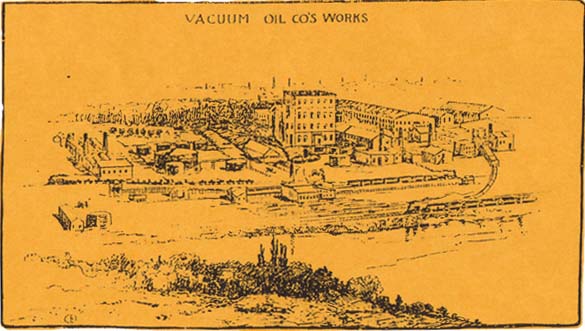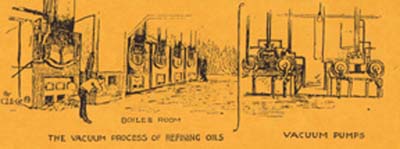|
A Chicken Coop Enterprise
or America's Most Successful Failure
by
We live in a world of machines—they manufacture our goods, they
move us from place to place, they occupy our working hours and they help
us to find relaxation during our free time. Most work smoothly because
they run on a film of oil lubricant. And how does this connect Rochester
to the world you may ask?
The answer lies in a chicken coop in a Monroe Avenue backyard and in
a man who some people refer to as the "world's most successful failure."
We'll start with the "failure" first.
He was Hiram Bond Everest, born in Pike, a tiny hamlet located some 40
miles southwest of our city. In 1849 he left his farm home with 250 dollars
to try his success as a school teacher in Wisconsin. He wasn't happy and
failed to continue. He then tried to raise apple trees. An especially
cold winter killed his orchard. He then moved to Ohio where he started
a vineyard. A killing frost wiped out this enterprise. Selling this farm
he then invested in some woodland near Cleveland. There Everest tried
to operate a sawmill. It burned to the ground. He rebuilt it and the mill
was destroyed by fire a second time.
Interestingly, his original capital of $250 went to $9000. With this
he started a new career in the spring of 1865—this time as a grocer
in Rochester. Among his patrons that winter was Matthew Ewing, a carpenter,
who lived on Monroe Avenue. He confided in Everest explaining his quest
for a way to extract kerosene from the newly discovered Pennsylvania crude
oil. Ewing felt that the world was ready for a better fuel to light their
lamps.
We can imagine Mrs. Ewing insisting that Matthew keep that "smelly" crude
oil out in the chicken coop while he worked on his vacuum process to distill
kerosene from it. At any rate Matthew was backed with money given to him
by Everest. On October 4th, 1866, the two men incorporated as partners
setting up a firm called the Vacuum Oil Company. Their product, termed
"Ewing's Patent Vacuum Oil," was first sold in the Boston area. After
a brief number of years Ewing and Everest dissolved their partnership.
Hiram wanted to create "a new and improved product from petroleum for
lubricating and other purposes" Matthew wanted to concentrate on kerosene.
History loses track of Ewing, but Everest's efforts are chronicled in
the 1917 issue of The Gargoyle World. In a biographical sketch
it relates how Hiram filled "square cans previously used for canned oysters;
and from this small beginning built a very considerable trade." The cans
contained a product most useful to the agricultural society of the day.
We discovered the nature of his venture on many early advertising cards
promoting "Vacuum Harness oil."
One such advertisement reads:
SAVE YOUR MONEY BY PRESERVING YOUR HARNESS
There is no way in which a farmer can save money so easily
and surely as by keeping his Harness soft and pliable with some good
Harness Oil. This prevents the Leather becoming brittle and cracking.
Impure Oils are often used and are apt to fry out upon the surface
in summer, which is very annoying. The VACUUM HARNESS OIL will not
fry out or Gum. It remains in the Leather for a long time and is an
absolute preventive against leather cracking.
Another ad suggests:
USE THE VACUUM HOOF OIL
A sure cure for ALL DISEASED HOOFS.
An excellent Liniment for Sprains, Wounds and other unhealthy conditions
of the hoof.
It is put up in Quart, Pint and Half-Pint Cans with Gilt Labels,
and warranted full measure.
Finally, we came across an advertising card showing a livery hand seated
with a pretty house maid on a box labeled Vacuum Harness Oil. The red-haired,
very Irish-appearing gentleman, has one hand around the maiden's shoulder
and is holding her hand with the other. His comment, written below the
scene, states:
Your hand is as soft, SWEET MISTRESS O'DOYLE,
As me harness whin rubbed wid VACUUM OIL.
By 1879 Hiram Bond Everest was a very successful and wealthy man. Through
his early failures he had learned much and he became considerably more
wealthy when he sold 75% of his Vacuum interests to John D. Rockefeller
and his Standard Oil Company. The initial $200,000 received was eventually
to grow to a $76,000,000 fortune. Not too shabby for a backyard chicken
coop enterprise between a grocer and a carpenter!
By now you may be able to see the connection between Everest and the
World. However it was his son, Charles Marvin Everest, who would truly
establish the business. Born in 1852, Charles was 25 when he took over
his father's business. The business office occupied the top floor of the
newly erected Wilder Building at Rochester's four corners. The vacuum
distillation plant was located near the corner of Mansion and Flint Streets
along the west bank of the Genesee River and the Erie Railroad line.

The harness oil plant turned to the production of lubrication oil for
machinery. It was called Gargoyle Oil and the name may well have been
inspired as Everest and his son looked down and across Main Street from
their Wilder Block offices at the old Elwood building's gargoyle downspouts.
Or perhaps they liked the poetic sound "gargoyle" made when linked with
the word "oil." Whatever the origin, the green gargoyle symbol found its
way around the world. National Geographic Magazine ads from the
1910 - 1914 era show its use from Cairo to Canton, from Rome to Rio and
across our nation. Vacuum Oil ads also provided a handy chart showing
the correct grade of oil for over 75 different makes of automobiles and
trucks.
In 1911, when the United States Supreme Court dissolved Standard Oil,
one part became Standard Oil of New York, popularly known as SOCONY, from
its cable address. The formal name was born, Socony-Vacuum Corporation,
and later, the Socony-Vacuum Oil Company, Inc. This company not only processed
crude from the United States but also oil from Arabia, Kuwait and Iran.
Over the years the name "Vacuum" was dropped and today we know it as the
Mobil Oil Corporation.
In 1917, the Rochester plant covered 20 acres, had 1200 employees and
produced approximately 50,000 barrels of lubricants per month. It was
not a refinery, but its 30 buildings were used for filtering, settling,
blending and compounding Gargoyle Lubricants and Gargoyle Mobiloils.

Additionally, the barrel factory produced 3500 oak barrels per day while
the can factory manufactured yearly "considerably over 3 million one-
and five-gallon cans, to be filled with Gargoyle Mobiloils."
Now this should end the chapter, however an equally interesting tale
revolves around Everest's invention of 600-weight cylinder lubricating
oil. Its high viscosity was precisely what another Rochesterian had been
searching for. One of the world's first automobiles, George Seldon's "road
engine" required just this type of lubricant.
Only later reflection helps us to understand the timeliness of this oil's
development in the 1870's. According to his son, George Seldon would never
have attempted to construct an automobile without the oil. It assured
the success of the internal-combustion engine. Further, George B. Seldon,
Jr., the auto inventor's son, was quoted as saying "Hiram Everest was
the city's greatest inventor. He made the automobile possible."
Thus we realize how truly connected Rochester was in the shaping of the
world's transportation future. The next time you get your oil changed,
tip your hat mentally to the memory of Hiram Bond Everest, the world's
most successful failure.
Illustrations supplied by author.
| 


